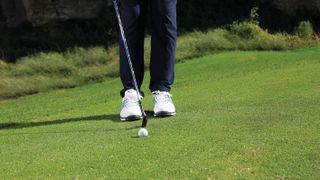We all play shots from time to time that can leave us in a fit of rage. Whether you’re struggling with a slice, going through a spell of the putting yips, or you’ve got a chronic case of topping of the golf ball, it’s important to know that there’s always a cure.
One of the most infuriating shots to play, especially given how close we can be to the flag, is a fat chip shot. We can hit a long drive 270 yards, play a half decent approach, and then, because our chipping technique lets us down, take three shots from no more than a dozen or so yards.
The best way to cure fatting the ball – whether it’s a chunky 3-wood, wedges from 100 yards, or around the green – is always to listen to the advice offered by our terrific panel of Top 50 Coaches. Here, Peter Finch explains how some simple adjustments around the green will help you to get-up-down with ease.
How To Stop Catching Chips Fat
Peter Finch
Delivering online free lessons to golfers across the globe with a combined social following of almost one million people, Peter is one of the most recognisable PGA professionals in the game.
1. Basic technique
The most common chipping faults result in loss of strike quality, with fats and thins stemming from golfers not understanding how to use bounce properly and control the low point through impact. Often this is because they have their hands too far forward and present the leading edge to the ground.
The best way to chip is to have the ball just inside the back foot, with the shaft pointing just to the left of your belt buckle. Your sternum should be in front of the ball at address, at the top and at impact. This way, you can use your shoulders and arms to move the club through impact.

Position the ball just inside the back foot to help with the strike when chipping
(Image credit: Kevin Murray)
2. Hitting down too much
If the lie’s not great or you want to keep the trajectory low, getting your hands forward is not bad advice on the face of it – it helps to steepen the angle of attack to deal with a poor lie or keep it low.
The problems arise when the hands push forward and lead the stroke through impact. It’s more about keeping the body and sternum together and allowing the club to brush through. You can…
..
Click Here to Read the Full Original Article at Latest from Golf Monthly in Tips…